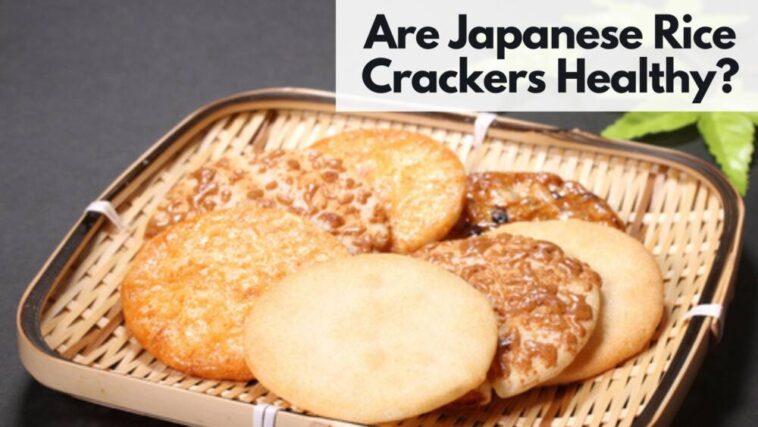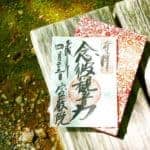Are Japanese rice crackers healthy? Here’s all you need to know about Japanese rice crackers from how Japanese rice are made to types of rice crackers. Check it out!.
Rice is a staple in Japan, so I wouldn’t be surprised if the major contributing factor in their snacks is also rice. Rice crackers are not as boring as they sound, especially if you’ve seen how innovative the Japanese can get with one simple thing.
Here’s the nutritional information for Japanese rice crackers:
| Nutrient | Amount Per 1 oz (28g) |
| Calories | 100-150 |
| Total Fat | 2-5g |
| Saturated Fat | 0-1g |
| Trans Fat | 0g |
| Cholesterol | 0mg |
| Sodium | 100-200mg |
| Total Carbohydrates | 20-25g |
| Dietary Fiber | 1-2g |
| Sugars | 0-1g |
| Protein | 2-4g |
| Calcium | 0-2% DV |
| Iron | 2-4% DV |
| Potassium | 2-4% DV |
| Vitamin C | 0% DV |
| Vitamin A | 0% DV |

A little background before we begin? These addictive little snacks are said to first be found in Sōka in Saitama, during the Edo period. The townspeople used to store all the extra rice during the harvest season in the form of dumplings and dried them for later consumption.
Little did they know that it would start to sell as a traveller’s snack at the Sōka station. Experimentation with soy bega and a binge snack was born. What’s better than a snack that’s healthy and munch-worthy?
Page Contents
Are Japanese Rice Crackers Healthy?
What are Japanese rice crackers made of?
These rice crackers are severely popular all across Japan. There are commonly called senbei (it is one of the types, but more on that later). They are wholesome and so simple to make. The ingredients that constitute it are rice, oil, and salt. Of course, people use a variety of add-ns to create the flavourful dish that it now is.
It is quite versatile. It can be a side dish with your main course, a midnight snack or even something to have with a couple of drinks. It’s just that good.
Nutritional facts about Japanese rice crackers
Let me break it down for you. 16 pieces of rice crackers come up to weigh around 28 grams. This total serving consists of 110 calories and just one gram of fat. Breaking it further down, 1 gram of fat equals 4 calories.
The best thing about these Japanese rice crackers is that none of the fat that makes up the cracker is saturated fat. When you’re trying to lose weight, not including saturated fat in your diet is a good way to go. Additionally, it also significantly lowers the risk of stroke and protects the health of your heart.
Other nutritional components that these crackers include are 2 grams of protein in the same amount of serving. Research indicates that that amount of protein accounts for around 4% of the protein intake women need every day and about 5% of the protein intake men need every day.
- Related: Why Are Japanese mangoes Expensive?
- Related: Why Japanese Eat Raw Fish
- Related: Are Japanese peanuts good for you
- Related: What is Hakusai?
Sodium Content in Japanese Rice Crackers
Rice, just on its own, can make the thing you’re eating quite bland. A major contributor to the flavouring of these Japanese rice crackers is salt. The 16 piece-28 calorie portion I was talking about earlier in total consists of 75 milligrams of sodium.
That much sodium roughly translates to 5% of the recommended amount of 1500 milligrams of sodium one is supposed to intake per day.
According to American Heart Association, this amount is perfectly healthy for those trying to keep their heart health in check. Staying within this limit also ensures that you avoid the risk of stomach cancer and kidney disease.
Do not mistake this data for all kinds of rice crackers, Japanese rice crackers are a healthy exception. Other rice crackers easily have a high sodium content. In fact, you can find as much as 120 mg of sodium in just a 100 grams portion.
That kind of snacking can be very addictive, leading to excessive consumption of sodium. Technically, our daily intake of sodium should be limited to a teaspoon worth of salt or even lesser.
Although the repercussions and sodium content are nowhere near the regular crackers, I wouldn’t recommend eating these Japanese rice crackers if you’re dealing with high blood pressure on a regular basis.
Related: Why Are Japanese Fruits SO Expensive?
What’s not there
As exciting as it sounds, as low-calorie a food item as it may seem, it is not the most holistic food. It has low calories, low sodium content, less fat, but it doesn’t have the required nutrients and minerals to give you the nutrition you need either.
Mainly, they don’t contain any fibre. Women who are trying to lose weight, or aren’t, need at least 25 grams of fibre in their meals, and men need at least 38 grams of the same. So, if you’re planning to use this as a major snack every day and fill up on this, it might actually not work out in your favour.
Besides, they don’t have the other necessary vitamins either. It has no signs of calcium, iron or any of the vitamins. One way to include that if you’re looking to eat Japanese rice crackers, is using a nutrient-rich spread. Low-fat cheese, hummus, ranch greek yoghurt dip, mango dip can change the flavour palate and also include the nutrients you need.
In fact, eating it with hummus can slow down the process of release of blood sugar in your body.
Related: Matcha Macarons Recipe to Try at Home!
Are Japanese Rice Crackers Healthier Than Chips?
With all that you have read until now, you’d probably come to the conclusion that Japanese rice crackers are a healthier alternative to chips, regular crackers or any crispy snack for that matter. That does maintain to an extent, but you have to keep in mind that these Japanese rice crackers are high in sodium, low in fibre and have less nutritional value.
An exact comparison might not be valid here. But using these Japanese rice crackers for tireless and binge munching is not ideal at all. Besides, add to all that the factor that manufacturers use artificial flavours to bring out new creations all the time, and you’re looking at consumption of MSG.
Well, research plays a key role here. Stand in the supermarket aisle and spend a considerable 10 minutes browning through the rice crackers section. Look out for the nutritional value section at the back of the packaging, look for words like “baked” and “not fried” and even “gluten-free”.
Even though the packaging says that it is still best to turn over and take a look at the list of ingredients that go into it. There can be too much rice flour, too much salt or sugar. In other words, they can be made with heavily refined rice that is packed with carbs.
People who are trying to battle obesity or weight loss, be careful. Do not think that Japanese rice crackers are a good alternative for chips.
Related: How to Cook Japanese Rice in a Rice Cooker?
Are Japanese Rice Crackers Fattening?
If you’re the kind of person who can’t stop when you’re supposed to stop, anything can be fattening. Make sure to take some out on a plate, rather than sitting with a packet that you can’t stop eating out of.
The non-fattening ingredients will only help you so long as you keep in mind how much is good for you.
Related: 4 Rules of Eating Healthy in Japan
How to Make the Japanese Rice Crackers Healthy?
A good way to change the low nutritional value of Japanese crackers is by making them healthy. Now you can’t fundamentally change the way it has been made, but you can pick what you eat it with. Try making a spread with hummus, cherry tomato and basil for your evening snack.
Another alternative could be to spread a thick layer of guacamole (rich in antioxidants) and sprinkling some seeds on it. A small number of 5-6 crackers eaten that way can subside hunger for a while. What will help most in maintaining health is portion control.
Types of Japanese Rice Crackers
Japanese cuisine offers a wide variety of crackers that are enjoyed as snacks or accompaniments to meals.
Here are some popular types of Japanese crackers:
Senbei
Traditional Japanese rice crackers, often round or square-shaped and made from glutinous rice. They come in various flavors like soy sauce, seaweed, sesame, or shrimp.
Arare
Small, bite-sized crackers made from glutinous rice, typically seasoned with soy sauce or other savory flavors. Arare crackers are often colorful and come in different shapes and textures.
Rice Crackers (Okaki)
Thin, crispy crackers made from rice and flavored with ingredients such as soy sauce, seaweed, or chili. They can be sweet or savory, and their texture can range from crunchy to puffed.
Kaki no Tane
Literally meaning “persimmon seed,” these unique crackers are a combination of crescent-shaped senbei and small peanuts. They are often seasoned with soy sauce and chili, providing a mix of flavors and textures.
Sembei
Similar to senbei, sembei crackers are made from rice but are typically larger and thicker. They can be savory or sweet, and their flavors vary from traditional soy sauce to matcha or even chocolate.
Kakinotane
Often served as a snack with drinks, kakinotane crackers are shaped like persimmon seeds and made from peanuts and spicy rice crackers. They offer a satisfying crunch and a balance of spiciness and nuttiness.
What Beverages Pair Well With Japanese Rice Crackers?
Pairing the right beverage with Japanese rice crackers can enhance the overall snacking experience.
Here are some popular beverage choices that complement Japanese rice crackers:
- Green Tea: A classic and versatile choice, green tea pairs well with various flavors of Japanese rice crackers. Its mild, slightly bitter taste and soothing properties make it an ideal match for both savory and sweet rice crackers.
- Sake: For those looking for an alcoholic beverage, sake can be a great option. The clean and delicate flavors of sake harmonize with the subtlety of rice crackers, especially with savory varieties like senbei or arare.
- Japanese Whisky: Japanese whisky, known for its smoothness and complexity, can provide an interesting contrast to the crisp texture of rice crackers. The nuanced flavors of whisky can complement the flavors of savory or sweet rice crackers.
- Plum Wine (Umeshu): This traditional Japanese liqueur made from steeping ume (Japanese plums) in alcohol offers a sweet and tangy taste. Its fruity notes can pair well with sweet or lightly flavored rice crackers.
- Matcha Latte: Matcha, a powdered green tea, blended with steamed milk creates a creamy and slightly bitter matcha latte. The earthy flavors of matcha can balance the sweetness of certain rice crackers, particularly those with chocolate or sweet coatings.
- Sparkling Water: If you prefer a non-alcoholic option, sparkling water can provide a refreshing and effervescent pairing for rice crackers. The crispness of the bubbles can cleanse the palate and enhance the flavors of the crackers.
- Citrus-infused Water: Infused water with a hint of citrus, such as lemon or yuzu, can add a bright and refreshing element to your rice cracker snacking. The citrus notes can complement the flavors of various rice cracker varieties.
Where To Buy Japanese Rice Crackers
One of the healthiest versions of Japanese rice crackers I found. These are wasabi flavoured KA-ME rice crackers, so you have the flavour and spice you need. The best part about these though is their low calorie and low-fat content. The total fat is only 2% of the total portion. Although it doesn’t have much nutritional value, you can implement some of the easy and quick modifications and make it a healthy snack, any time of the day!
Also Read:





